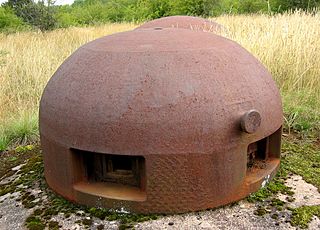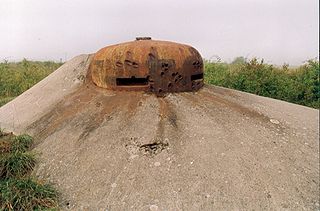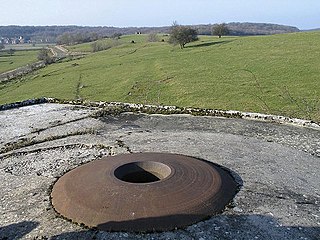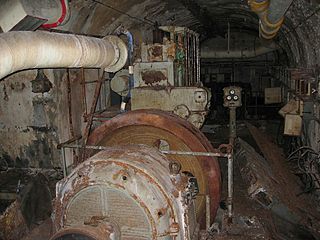
The GFM cloche was one of the most common defensive armaments on the Maginot Line. A cloche (bell) was a fixed and non-retractable firing position made of a thick iron casting which shielded its occupant. By comparison, turrets could be rotated and sometimes lowered so that only the top shell was exposed.

The JM cloche is an element of the Maginot Line. It is a non-retractable non-rotating cupola of steel alloy like GFM cloches, but are armed with twin heavy machine guns, as opposed to the lighter automatic rifles associated with the GFM. There are 179 JM cloches on the Maginot Line.
Ouvrage Coucou is a lesser work of the Maginot Line, located in the Fortified Sector of Boulay. The ouvrage consists of two infantry blocks, and is located between the gros ouvrages of Hackenberg and Mont des Welches, facing Germany, just north of Kemplich.

Ouvrage Hobling is a lesser work of the Maginot Line. Located in the Fortified Sector of Boulay, the ouvrage consists of two infantry blocks and two observation blocks, and is located between gros ouvrage Michelsberg and petit ouvrage Bousse, facing Germany. It has been stripped of metals and abandoned.
Ouvrage Bousse, also known as Ouvrage Bois de Bousse, is a lesser work of the Maginot Line in the Fortified Sector of Boulay. The ouvrage is located between petit ouvrage Hobling and gros ouvrage Anzeling, near Hestroff in the Bois du Bousse, facing Germany. A small position, it was manned primarily by reservists. It is noted for the events of 15 June 1940, when it received orders to prepare for an evacuation as German forces advanced along the Line in the Battle of France. As the garrison prepared to abandon the position, sabotaging equipment, they destroyed their telephone connection, leaving them unable to receive the order countermanding the evacuation. The garrison was captured three days after leaving Bousse. Bousse is now managed as a museum and is open to public visitation.
Ouvrage Berenbach, also known as Ouvrage Behrenbach, is a lesser work of the Maginot Line. Located in the Fortified Sector of Boulay, the ouvrage is located between gros ouvrage Anzeling and petit ouvrage Bovenberg, facing Germany. The ouvrage consists of two infantry blocks and one observation block. Uniquely, the blocks are not connected by subterranean galleries, as is the case in virtually all other Maginot fortifications.

Ouvrage Coume Annexe Sud is a lesser work of the Maginot Line. Located in the Fortified Sector of Boulay, the ouvrage consists of two infantry blocks, one artillery block and one observation block, and is located between petits ouvrages Coume and Mottemberg, facing Germany.
Ouvrage Mottenberg is a lesser work of the Maginot Line. Part of the Fortified Sector of Boulay, the ouvrage consists of one entrance block and two infantry blocks, and is located between petits ouvrages Coume Annexe Sud and Kerfent, facing Germany.

Ouvrage Laudrefang is a lesser work of the Maginot Line. Located in the Fortified Sector of Faulquemont, the ouvrage consists of one infantry block, and is located between petits ouvrages Einseling and Teting, facing Germany. Laudrefang was originally planned as a gros ouvrage. With a heavy armament for a petit ouvrage it successfully defended its neighbors against German attack during the Battle of France. Laudrefang is abandoned and flooded, and was heavily damaged by German bombardment in 1940.
Ouvrage Mauvais-Bois is a petit ouvrage of the Fortified Sector of the Crusnes on the Maginot Line. It is located between the gros ouvrage Latiremont and the petit ouvrage Bois-du-Four, facing the Belgium/Luxembourg border. The original plan for the position was for two phases of construction, resulting in a gros ouvrage provided with heavy artillery. The increase in tension between France and Germany in the late 1930s caused resources to be diverted elsewhere, and only the first three combat blocks were built. In 1940 the ouvrage was regularly bombarded, but not directly attacked by German infantry. When the French military divested itself of the majority of the Maginot fortifications, Mauvais-Bois was the second to be sold.
Ouvrage Bréhain is part of the Fortified Sector of the Crusnes of the Maginot Line, located near the community of Bréhain-la-Ville in the Meurthe-et-Moselle department of France. Bréhain is flanked by petits ouvrages Mauvais Bois and Aumetz. The gros ouvrage was equipped with long-range artillery, and faced the border with Luxembourg. It saw no major action in either the Battle of France in 1940 or the Lorraine Campaign of 1944. While not open to public visitation, it has been secured and is in relatively good condition when compared to other abandoned Maginot positions. A flanking casemate has been restored and may be visited.

The LG cloche was a defensive element common to many Maginot Line ouvrages. The fixed cupola was deeply embedded into the concrete on top of a combat block, with only the top surface visible. The opening permitted the ejection of grenades from the interior of the cloche, providing a means of close defense against enemy troops on top of the bunker. 75 units were installed in the Maginot Line.

Ouvrage Soetrich is a gros ouvrage of the Maginot Line in north-eastern France. Soetrich is located between petits ouvrages Immerhof and Bois Karre, facing the France-Luxembourg border near the town of Hettange-Grande, part of the Fortified Sector of Thionville. Compared with other gros ouvrages, Soetrich is compact in arrangement, with the entries and underground ammunition magazines and barracks in close proximity to the combat blocks, accessed through underground galleries at an average depth of 30 metres (98 ft). Its primary purpose was to cover the main road to Luxembourg, just to the west. Along with its neighbours, Ouvrage Rochonvillers and Ouvrage Molvange, Soetrich was used during the Cold War as a secure command centre for NATO forces.

Ouvrage Galgenberg forms a portion of the Fortified Sector of Thionville of the Maginot Line. It is situated in the Cattenom Forest, near the gros ouvrage Kobenbusch and petit ouvrage Oberheid. The ouvrage was tasked with controlling the Moselle Valley and as such was called the "Guardian of the Moselle." Galgenberg did not see significant action in 1940 or 1944. After a period of reserve duty in the 1950s and 1960s, it was deactivated. It is now a museum.
Ouvrage Schiesseck is a gros ouvrage of the Maginot Line, located near Bitche in the French département of Moselle. Schiesseck is adjoined by gros ouvrage Simserhof and petit ouvrage Otterbiel, all part of the Fortified Sector of Rohrbach, and faces the German frontier. Schiesseck saw comparatively little activity during the Battle of France, surrendering with other positions in its sector on 30 June 1940. During the Lorraine Campaign of 1944 Schiesseck was occupied by German forces and presented a point of resistance to American advances, requiring heavy bombardment and infantry assaults by engineer units to capture. The area was abandoned during the Battle of the Bulge, but was recaptured in March 1945. In the 1950s Schiesseck was repaired as part of a program to re-arm the Maginot Line against a potential advance by Warsaw Pact forces. It was abandoned in the early 1970s. Schiesseck is on military land and is not visitable by the public.
Ouvrage Grand-Hohékirkel is a petit ouvrage of the Maginot Line, located near Bitche in the French département of Moselle. Grand-Hohékirkel is adjoined by gros ouvrage Otterbiel to the west and petit ouvrage Lembach at some distance to the east, and faces the German frontier. It was part of the Fortified Sector of the Vosges.

Ouvrage Lembach is a petit ouvrage of the Maginot Line. Lembach is adjoined by petit ouvrage Grand Hohekirkel at some distance to its west and gros ouvrage Four-à-Chaux immediately to its east. It faces the German frontier, and was part of the Fortified Sector of the Vosges. During the Battle of France in 1940, the German 215th Infantry Division broke through the line of smaller fortifications to the west of Lembach, but did not directly attack. After aerial bombardments, Lembach surrendered with the rest of the Maginot fortifications according to the terms of the Second Armistice at Compiègne. After the war Lembach was renovated for further use, but was abandoned by the 1970s.
Ouvrage Vélosnes is a gros ouvrage of the Maginot Line, located in the Fortified Sector of Montmédy between the towns of Othe and Vélosnes, facing Belgium. It possesses four combat blocks and one entrance block. It is located to the east of petit ouvrage Thonnelle. The position was sabotaged and abandoned by French forces that were ordered to retreat from the exposed position in June 1940 during the Battle of France. The ouvrage is abandoned and is administered as a nature preserve.

Ouvrage Thonnelle is a petit ouvrage of the Maginot Line, located in the Fortified Sector of Montmédy between the towns of Thonnelle and Verneuil-Petit, facing Belgium. It possesses four combat blocks. It is located between gros ouvrages Vélosnes and Chesnois. The position was sabotaged and abandoned by French forces that were ordered to retreat from the exposed position in June 1940 during the Battle of France. The ouvrage is abandoned.

Ouvrage Chesnois, also known as Ouvrage Chênois, is a gros ouvrage of the Maginot Line, located in the Fortified Sector of Montmédy, facing Belgium. The ouvrage lies between the towns of Montlibert and Thonne-le-Thil. It possesses six combat blocks. It is located between gros ouvrage Thonnelle and petit ouvrage La Ferté. The position was sabotaged and abandoned by French forces that were ordered to retreat from the exposed position in June 1940 during the Battle of France. The ouvrage is now abandoned and sealed.











